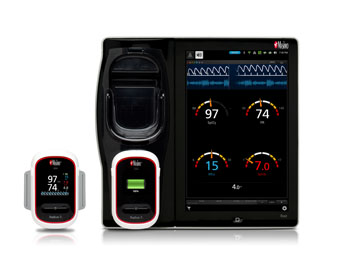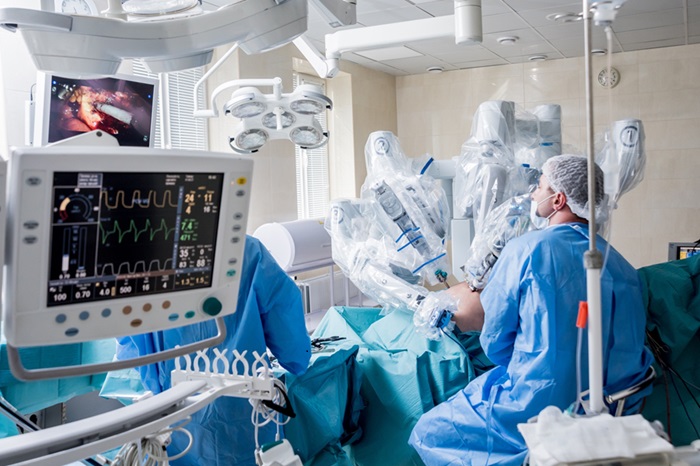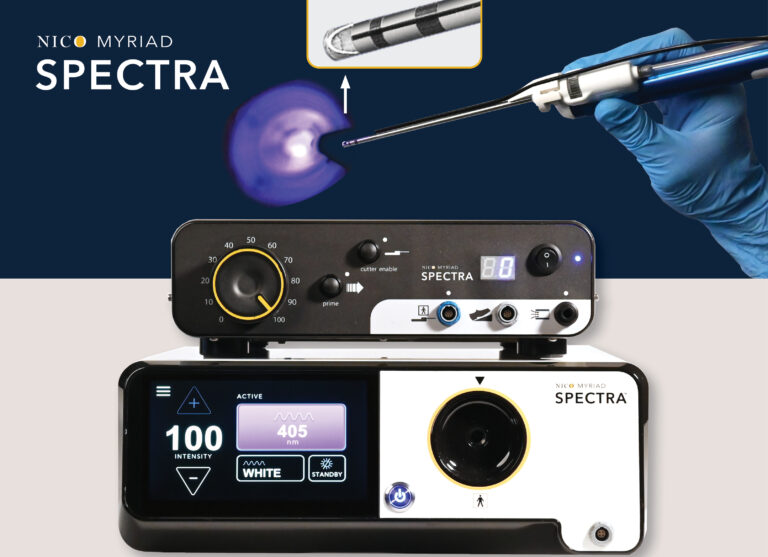Tetherless Monitor Continuously Measures Hemoglobin Concentration
|
By HospiMedica International staff writers Posted on 14 Jul 2016 |

Image: The Radius-7 with Root (Photo courtesy of Masimo).
A novel wearable device enables non-invasive monitoring of more than 10 parameters, including continuous total hemoglobin concentration (SpHb).
The Masimo (Irvine, CA, USA) Radius-7 with Root is a lightweight device that provides rainbow SET noninvasive sensor technology, which uses more than seven wavelengths of light to acquire blood constituent data based on light absorption. Indices measured include blood oxygen saturation (SpO2), pulse rate, and perfusion index (PI). Advanced signal processing algorithms and unique adaptive filters work together to isolate, identify and quantify various hemoglobin species, including SpHb.
The Radius-7 with Root attaches to the arm, allowing untethered monitoring whether a patient is in or out of bed, thus reducing the need for nursing assistance to disconnect from or reconnect to a bedside monitor. The Radius-7 communicates to Root at the bedside, and thereon to the Masimo Patient SafetyNet in order to alert clinicians of critical changes in oxygen saturation, pulse rate, respiration, and hemoglobin, among other parameters. Each Radius-7 comes with two “hot-swappable” rechargeable battery modules, each with a battery life of 12 hours, to minimize monitoring interruption.
“Never before could patients be monitored for such key parameters as continuous SpHb, which can help clinicians make more timely and informed blood management decisions, while patients are fully mobile,” said Joe Kiani, founder and CEO of Masimo. “Root with Radius-7 with rainbow SET, coupled with Patient SafetyNet for mobile clinician notification, is now an even more versatile and powerful monitoring system, all while promoting freedom of patient movement and quicker recovery times.”
“We are monitoring SpHb for selected postsurgical patients, which can be extremely beneficial because it can provide insight into hemoglobin trends between invasive blood samplings,” said professor of anesthesiology and intensive care Christer Svensen, MD, of Karolinska Institute (Stockholm, Sweden). “Such insight may lead clinicians to confirm trends by performing blood draws sooner than they might otherwise have done, which may then suggest the need to intervene.”
SpHb monitoring may provide insight to the directional trend of hemoglobin between invasive blood samplings. For example, when SpHb trend is stable, and the clinician may otherwise think hemoglobin is decreasing; when SpHb trend is rising, and the clinician may otherwise think hemoglobin is not rising fast enough; or when the SpHb trend is decreasing, and the clinician may otherwise think hemoglobin is stable.
Related Links:
Masimo
The Masimo (Irvine, CA, USA) Radius-7 with Root is a lightweight device that provides rainbow SET noninvasive sensor technology, which uses more than seven wavelengths of light to acquire blood constituent data based on light absorption. Indices measured include blood oxygen saturation (SpO2), pulse rate, and perfusion index (PI). Advanced signal processing algorithms and unique adaptive filters work together to isolate, identify and quantify various hemoglobin species, including SpHb.
The Radius-7 with Root attaches to the arm, allowing untethered monitoring whether a patient is in or out of bed, thus reducing the need for nursing assistance to disconnect from or reconnect to a bedside monitor. The Radius-7 communicates to Root at the bedside, and thereon to the Masimo Patient SafetyNet in order to alert clinicians of critical changes in oxygen saturation, pulse rate, respiration, and hemoglobin, among other parameters. Each Radius-7 comes with two “hot-swappable” rechargeable battery modules, each with a battery life of 12 hours, to minimize monitoring interruption.
“Never before could patients be monitored for such key parameters as continuous SpHb, which can help clinicians make more timely and informed blood management decisions, while patients are fully mobile,” said Joe Kiani, founder and CEO of Masimo. “Root with Radius-7 with rainbow SET, coupled with Patient SafetyNet for mobile clinician notification, is now an even more versatile and powerful monitoring system, all while promoting freedom of patient movement and quicker recovery times.”
“We are monitoring SpHb for selected postsurgical patients, which can be extremely beneficial because it can provide insight into hemoglobin trends between invasive blood samplings,” said professor of anesthesiology and intensive care Christer Svensen, MD, of Karolinska Institute (Stockholm, Sweden). “Such insight may lead clinicians to confirm trends by performing blood draws sooner than they might otherwise have done, which may then suggest the need to intervene.”
SpHb monitoring may provide insight to the directional trend of hemoglobin between invasive blood samplings. For example, when SpHb trend is stable, and the clinician may otherwise think hemoglobin is decreasing; when SpHb trend is rising, and the clinician may otherwise think hemoglobin is not rising fast enough; or when the SpHb trend is decreasing, and the clinician may otherwise think hemoglobin is stable.
Related Links:
Masimo
Latest Critical Care News
- Portable System for Warming Blood and IV-Fluids Reduces Hypothermia Risk in Hemorrhaging Patients
- AI-Generated Real-Time Alerts for Declining Health Speeds Up Treatment and Reduces Hospital Deaths
- Breakthrough Computational Method Predicts Sudden Cardiac Death
- Ingestible Microbiome Sampling Pill to Help Diagnose Wide Range of Health Conditions
- GPS-Like Smart Pills with AI Provide Real-Time 3D Monitoring Of Gastrointestinal Health
- Bioengineering Breakthrough to Improve Bone Regeneration Treatments
- Soft Robots with Electronic Skins and Artificial Muscles to Provide Medical Treatment
- AI Camera Technology Helps Doctors Quickly Assess Severity of Infections
- Machine Learning Delivers Personalized Oxygenation for Patients on Ventilators
- New AI Algorithm Detects Rare Epileptic Seizures from EEG Data
- Facial Thermal Imaging Combined with AI Predicts Coronary Artery Disease
- AI Technology Predicts Cardiac Events 10 Years in Advance
- Recyclable ‘Smart Skin’ Monitors Biological Signals on Demand
- Novel Catheter to Reduce Risk for Associated Urinary Tract Infections and Sepsis
- AI Doubles Medical Professionals’ Accuracy in Reading EEG Charts of ICU Patients
- Flexible Device Enables Sweat Gland Stimulation and Simultaneous Biosensing
Channels
Surgical Techniques
view channel
Total Robotic Metabolic and Bariatric Surgery Proves More Beneficial than Conventional Laparoscopy
According to the U.S. Centers for Disease Control and Prevention (CDC), 42.4% of Americans are affected by obesity. Research indicates that obesity can compromise the immune system, trigger chronic inflammation,... Read moreWirelessly Activated Robotic Device Aids Digestion in Patients with Compromised Organs
The transport of fluids and solids is essential in the human body, driven by a wave-like movement in the lumen known as peristalsis. However, peristalsis can be disrupted in patients who have obstructions... Read morePatient Care
view channelFirst-Of-Its-Kind Portable Germicidal Light Technology Disinfects High-Touch Clinical Surfaces in Seconds
Reducing healthcare-acquired infections (HAIs) remains a pressing issue within global healthcare systems. In the United States alone, 1.7 million patients contract HAIs annually, leading to approximately... Read more
Surgical Capacity Optimization Solution Helps Hospitals Boost OR Utilization
An innovative solution has the capability to transform surgical capacity utilization by targeting the root cause of surgical block time inefficiencies. Fujitsu Limited’s (Tokyo, Japan) Surgical Capacity... Read more
Game-Changing Innovation in Surgical Instrument Sterilization Significantly Improves OR Throughput
A groundbreaking innovation enables hospitals to significantly improve instrument processing time and throughput in operating rooms (ORs) and sterile processing departments. Turbett Surgical, Inc.... Read moreHealth IT
view channel
Machine Learning Model Improves Mortality Risk Prediction for Cardiac Surgery Patients
Machine learning algorithms have been deployed to create predictive models in various medical fields, with some demonstrating improved outcomes compared to their standard-of-care counterparts.... Read more
Strategic Collaboration to Develop and Integrate Generative AI into Healthcare
Top industry experts have underscored the immediate requirement for healthcare systems and hospitals to respond to severe cost and margin pressures. Close to half of U.S. hospitals ended 2022 in the red... Read more
AI-Enabled Operating Rooms Solution Helps Hospitals Maximize Utilization and Unlock Capacity
For healthcare organizations, optimizing operating room (OR) utilization during prime time hours is a complex challenge. Surgeons and clinics face difficulties in finding available slots for booking cases,... Read more
AI Predicts Pancreatic Cancer Three Years before Diagnosis from Patients’ Medical Records
Screening for common cancers like breast, cervix, and prostate cancer relies on relatively simple and highly effective techniques, such as mammograms, Pap smears, and blood tests. These methods have revolutionized... Read morePoint of Care
view channel
POCT for Infectious Diseases Delivers Laboratory Equivalent Pathology Results
On-site pathology tests for infectious diseases in rural and remote locations can achieve the same level of reliability and accuracy as those conducted in hospital laboratories, a recent study suggests.... Read more
Cartridge-Based Hemostasis Analyzer System Enables Faster Coagulation Testing
Quickly assessing a patient's total hemostasis status can be critical to influencing clinical outcomes and using blood products. Haemonetics Corporation (Boston, MA, USA) has now obtained 510(k) clearance... Read more
Critical Bleeding Management System to Help Hospitals Further Standardize Viscoelastic Testing
Surgical procedures are often accompanied by significant blood loss and the subsequent high likelihood of the need for allogeneic blood transfusions. These transfusions, while critical, are linked to various... Read moreBusiness
view channel
BD Acquires Edwards Lifesciences' Critical Care Product Group for USD 4.2 Billion
BD (Becton, Dickinson and Company, Franklin Lakes, NJ, USA) and Edwards Lifesciences (Irvine, CA, USA) have entered into a definitive agreement under which BD will acquire Edwards' Critical Care product... Read more


















